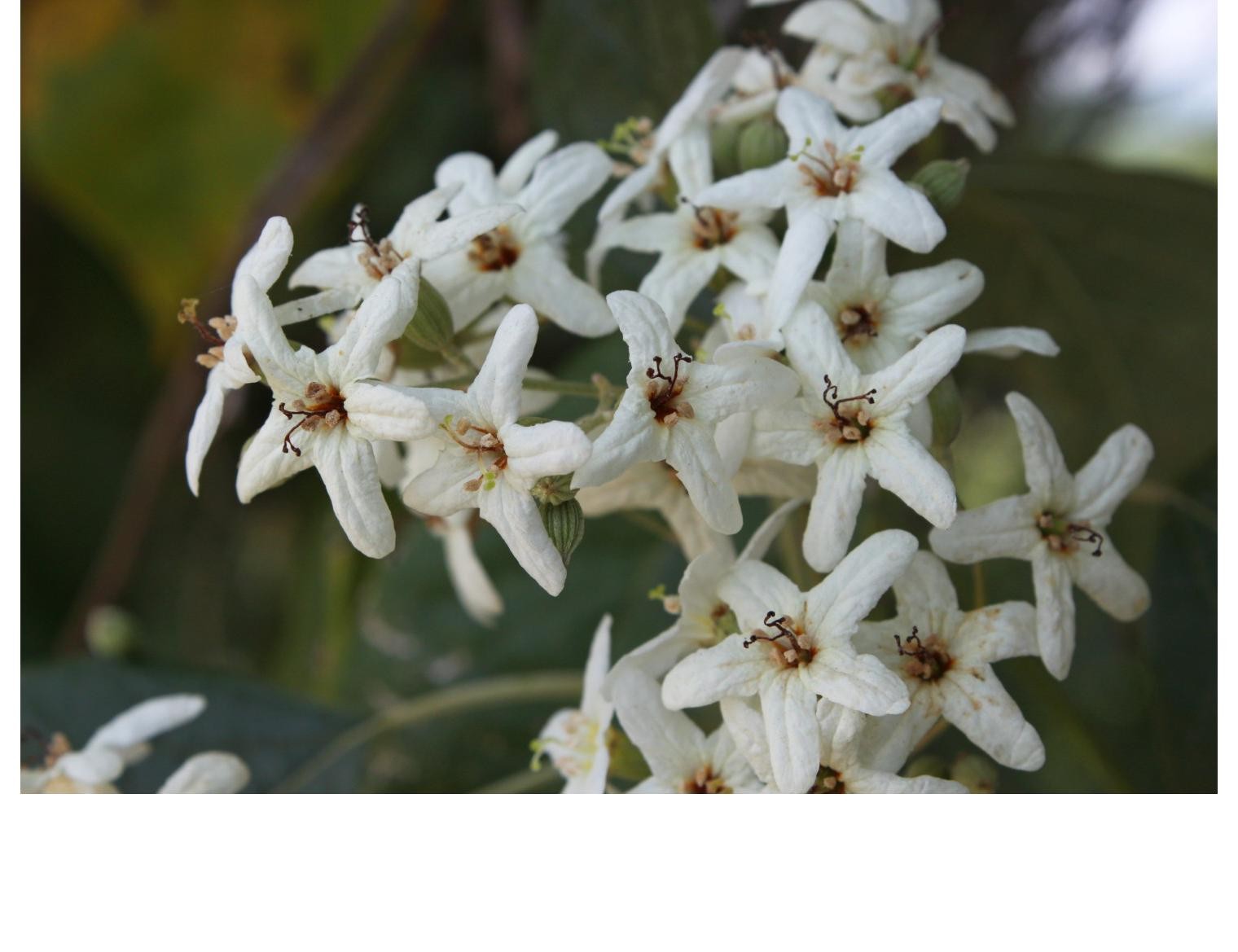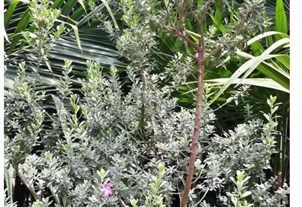By Tommy Clarkson on the March 2021 Edition
Physic Nut Jatropha integerrima – or, possibly, J. pastada or J. coccinea
Family Euphorbiaceae
Also known as Nettlespurge or Rose-flowered Jatropha
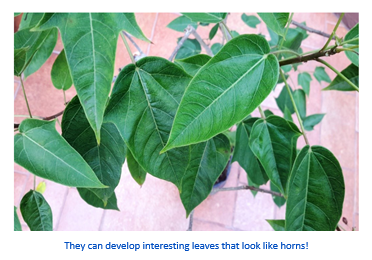 Ever in search of new species of tropical or semi-tropical plants that will complement the others in our gardens, I was recently delighted to come upon this perennial – but was rather puzzled regarding its botanical specifics. (Actually, this is a writer’s classic way of saying that, in point of actuality, I had no idea whatsoever what it was!)
Ever in search of new species of tropical or semi-tropical plants that will complement the others in our gardens, I was recently delighted to come upon this perennial – but was rather puzzled regarding its botanical specifics. (Actually, this is a writer’s classic way of saying that, in point of actuality, I had no idea whatsoever what it was!)
Thus, I was delighted when I narrowed its identification to the family of Jatropha – with help from Dr. Mark Olson and Dr. Arthur Whistler.
(Now, to a degree, that begs an interesting question. Technically speaking, can someone rather significantly junior in age – but vastly more educated, experienced and knowledgeable in this field then me – still be called such? Well, given the breadth and depth of his plant awareness – to say nothing of his generosity and willingness to share all manner of tropical botanical plant information with me, I must most absolutely say, a definite, yes!)
Along with the name, he kindly informed me that, “You are in a Jatropha hotspot, with at least six wild species in the area, including the super charismatic Jatropha chamelensis, which has a big trunk with golden papery bark and leaves like huge, green, dinner plates.”
Beyond that, those who have copies of Volume I and II or our book series – based on plants in our Ola Brisa Gardens – “The Civilized Jungle,” will recall that the Gout Plant (Jatropha po-dagrica) was discussed in the former and the Coral Plant (Jatropha multifidi) in the latter.
Hence, it should logically follow that Jatropha coccinea should be in Volume III. (Now to decide when to write about Jatropha curcas, J. gossypifolia, J. integerrima, J. ortegae and some of the others with which I am more personally familiar!)
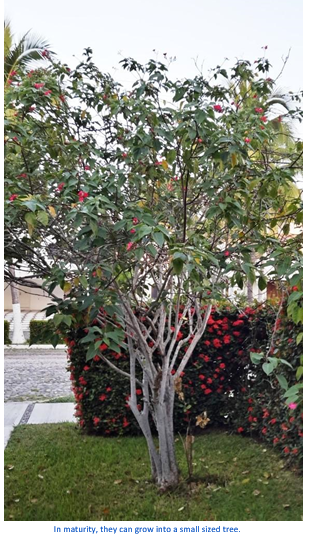 The some 150 species in this genus range from smallish herbs, through medium-sized shrubs to smaller, tree-sized plants. Some are perennials while yet others are annuals. Tropical and semi-tropical in nature, they range all around the world. Per-haps their greatest diversity may be found in Africa and the Americas. They prefer sandy, non-water retaining soil and can be propagated by either cuttings or seed.
The some 150 species in this genus range from smallish herbs, through medium-sized shrubs to smaller, tree-sized plants. Some are perennials while yet others are annuals. Tropical and semi-tropical in nature, they range all around the world. Per-haps their greatest diversity may be found in Africa and the Americas. They prefer sandy, non-water retaining soil and can be propagated by either cuttings or seed.
Their primary commonality is the similarity of their flower structures. They like sun to partial shade and regular watering. They can be all monoecious (meaning that they have both male and female flowers on the same plant or dioecious (on different plants). These blooms are found most attractive by butterflies. Moreover, while all parts of the plant are poisonous, the seeds from them is being studied as a potential fuel alternative! I kid you not!
Prone to more sun than shade, our new specimen is the subject of an experiment. It is presently nestled in a hanging basket on the southeastern side of our dining palapa. Its neighbors – on that side – include a lush fern, an intriguing vine that I have yet to identify, a Christmas Cactus, a carnivorous Pitcher Plant and a white Geranium. (Yes, I readily admit the latter to not being “tropical per se” but my Grandmother (Rose Unruh) loved them, so it is there in her honor!)
So far, it has done rather well but we will have to study the effects of a full year of seasonal sun direction change.
The medium-sized leaves of this species – and for what reason I have no idea – cause the word “elfin” to come to mind! They are a bit unique . . . and rather attractive, with their two “pointy -outy” (Don’t you love it when I use these highly technical botanical terms?) spiked sides on the upper part of the lamina (blade, or the principle part which most of us folks think of as the leaf proper) not far down from the stem!
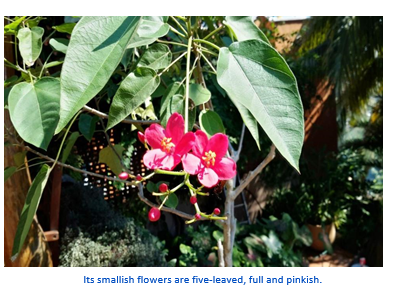 These – all by themselves – keep the leaf from having the more classical, oval shape. They are pretty, in a leaf sort of way, pure, simple and basic green in colorization. The smallish flowers are five-leaved, full and pinkish.
These – all by themselves – keep the leaf from having the more classical, oval shape. They are pretty, in a leaf sort of way, pure, simple and basic green in colorization. The smallish flowers are five-leaved, full and pinkish.
Now, though we’ve had our specimen not all that long, my suggestions as to properly growing and maintaining a Jatropha coccinea would be in moderate to slightly filtered sunlight – not protracted hours of hot sun – definitely planted in well-draining soil, and watering once it begins to dry out (via proper usage of a hydrometer) about three to four inches down into the roots and applying a general floral fertilizer monthly.
—
Tommy Clarkson is a bit of a renaissance man. He’s lived and worked in locales as disparate as the 1.2 square mile island of Kwajalein to war-torn Iraq, from aboard he and Patty’s boat berthed out of Sea Bright, NJ to Thailand, Germany, Hawaii and Viet Nam; He’s taught classes and courses on creative writing and mass communications from the elementary grades to graduate level; He’s spoken to a wide array of meetings, conferences and assemblages on topics as varied as Buddhism, strategic marketing and tropical plants; In the latter category he and Patty’s recently book, “The Civilized Jungle” – written for the lay gardener – has been heralded as “the best tropical plant book in the last ten years”; And, according to Trip Advisor, their spectacular tropical creation – Ola Brisa Gardens – is the “Number One Tour destination in Manzanillo”.

